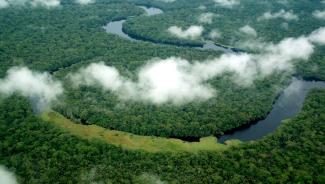The Central Africa Regional Program for the Environment (CARPE) is the largest environment program funded by USAID. Its objective is to maintain the ecological integrity of the second largest tropical humid forest ecosystem in the world, the Congo Basin. To achieve this objective, CARPE implements two interdependent programs: Central Africa Forest Ecosystems Conservation (CAFEC) and Environmental Monitoring and Policy Support (EMAPS).
The information collected and shared through the local efforts of CAFEC informs national and regional policy work, while improved policies supported under EMAPS allow for better conservation efforts and land use management at the local landscape level. These programs align with and contribute to the National Strategy for Combating Wildlife Trafficking (CWT).
Central Africa Forest Ecosystems Conservation (CAFEC)
CAFEC focuses on sustainable forest management and wildlife conservation activities in nine carbon rich, biologically sensitive and diverse natural forest landscapes throughout the RoC and the DRC.
USAID’s implementing partners – the African Wildlife Foundation, Wildlife Conservation Society, the World Wildlife Fund and African Parks – protect and build capacity to manage these landscapes covering 32 million hectares of land, seven landscapes in the Democratic Republic of the Congo and two in the Republic of Congo.
8.Virunga
Environmental Monitoring and Policy Support (EMAPS)
EMAPS improves national and regional environmental policy and regulatory capabilities for sustainable forest and biodiversity conservation management. EMAPS also improves monitoring, contributes to analysis, and shares information about biodiversity, forest cover change, and forest-based greenhouse gas emissions and carbon sequestration to help maintain the ecological integrity of the Congo Basin’s humid forest ecosystem.
The National Aeronautics and Space Administration (NASA), the University of Maryland and the Central Africa Forest Satellite Observatory (OSFAC) collaborate to produce detailed analyses of forest change across the Congo Basin. To help ensure this information is included in policy-making and regulatory mechanisms, the NASA-led consortium partners, with a second EMAPS consortium led by the World Resources Institute, and includes the African Wildlife Foundation, Wildlife Conservation Society, World Wildlife Fund and the Council for the Defense of the Environment ensure that these detailed are included in mechanisms for policy rules and regulations decision making processes through Legality and Traceability

Credit Cody Pope

